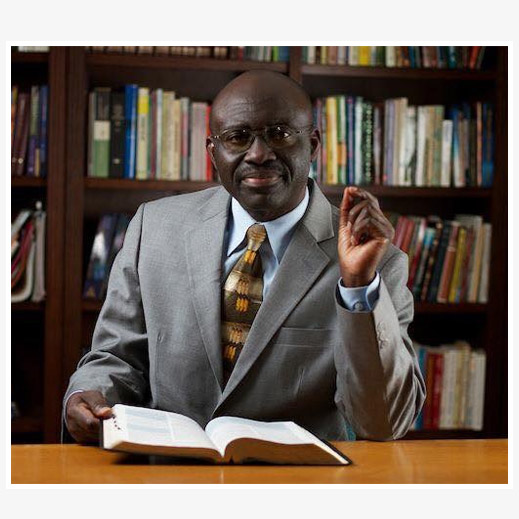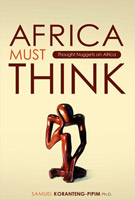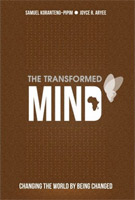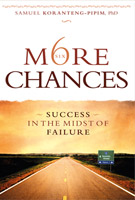Separate Black and White Conferences--Part 1
SEPARATE BLACK AND WHITE CONFERENCES—Part 1
The Sin We Don’t Want To Overcome[Article Excerpted from Author’s Must We Be Silent?]
By
Samuel Koranteng-Pipim, PhD
Director, Public Campus Ministries, Michigan Conference
Can the good news of God’s amazing grace address the baneful shortcomings of our mazing (confusing) race? Every Christian denomination has had to deal with this thorny question as it has confronted racism in its manifold expressions. Whether we are talking about tribalism in Africa, ethnic cleansings and neo-Nazism in Europe, Black and White racism in North America, etc., the challenge is the same. What should be the Christian’s response to racial prejudice and discrimination?
Our Seventh-day Adventist church is today grappling with what to do with its racially segregated conference system in North America. Should we continue to maintain this structure? Or should we tear down the walls? This chapter continues our discussion from the previous chapter, looking at four more myths regarding the validity of separate Black and White conferences. We shall look at how these racially segregated conferences came into being, and what we ought to do about them.
Those who are unwilling to dismantle the existing racial structures in the church sometimes argue that the current arrangement was demanded by Blacks. The unspoken assertion implied in this argument is that either Blacks are responsible for the structural racism that exists or, at the very least, they prefer to maintain the current Regional (Black) conference system.
This popular myth is a naive oversimplification of what actually prompted the Regional conferences. It also erroneously assumes that whatever a group of people prefer is necessarily right.
A little over a decade ago, two non-Adventist scholars offered an unflattering critique of the Seventh-day Adventist church. They noted that “although the relationship between whites and blacks in the church was never one of master-servant, it was certainly one of master-pupil.” In their assessment, “the Adventist black, who, although perhaps loved by his white brothers, has never been totally convinced that they want him to sit with them.” It is against this background that these scholars identify the formation of Black (Regional) conferences in 1944 as “the most important institutional development” in the SDA church. [1]
The above comment may be a little exaggerated. But there is some validity in their claims regarding Black-White church relations in the United States–at least in the years following Ellen G. White’s death in 1915. During this period, many loyal Adventists suffered racial discrimination simply because they were Black. A number of prominent Black Adventist ministers and layperson also gave up their affiliation with the Adventist church because of its treatment of Blacks. [2]
One Adventist scholar writes: “White Adventist congregations and administrative leadership positions were rarely accessible to Blacks prior to the 1940s. The first Black person to work at the General Conference was the director of the Negro Department. Neither he nor Black visitors to the General Conference were permitted to eat in the Review and Herald cafeteria (the eating place for the General Conference workers at the time). Segregation was the norm for the first half of the 1900s. Across the United States the denomination’s schools and institutions did not yet have an equitable admissions policy.” [3]
The Creation of Black (Regional) Conferences. Although serious discussions had been going on since 1889 for the creation of separate Black conferences, [4] the spark that ignited the flame for immediate action to organize Regional conferences was an unfortunate racial incident at our Washington Adventist hospital in 1943. [5]
In October 1943, Bro. Byard took his wife, Lucy, to the Washington Adventist Sanitarium and Hospital in Takoma Park, Maryland for medical treatment. Both Bro. Byard and his wife were Black, but of a very light complexion. They were also longtime Adventists from Brooklyn, New York. Because she was gravely ill, Lucy Byard was brought by an ambulance and was admitted without hesitation. But before treatment was begun, her admission slip was reviewed. When her racial identity was discovered, she was told a mistake had been made. Without examination or treatment, she was wheeled from her hospital room into a corridor as the hospital staff called around to other hospitals to transfer the patient. She was transferred by automobile–not even granted the use of an ambulance–across State line to the Freeman’s Hospital, where she later died of pneumonia. According to rumor, she contracted this pneumonia while waiting in the hallway of the hospital wearing only a hospital gown. This incident, along with similar cases of racial discrimination stirred the Black constituency immeasurably.
They demanded that the General conference act to ensure that such discriminatory and inhumane treatment of blacks would not occur again. The Black members were not only concerned about admittance to hospitals, but the whole questions of quotas in schools, lack of employment in church institutions, and a general absence of solicitude for them in the church were subjects of their protest. They employed the press and pulpit to whip up sentiment in their favor.
To quiet the brethren, Elder W. G. Turner, an Australian and President of the North American Division, went to the Ephesus church in Washington, D.C. (now the DuPont Park church), the next Sabbath, October 16, 1943. He chose as his text 1 Peter 4:12: “Beloved, think it not strange concerning the fiery trial which is to try you as though some strange thing happened unto you.” He had hardly sat down after completing his message when brother James O. Montgomery (father of Alma Blackmon, for many years the director of Oakwood College’s choir) stepped to the front of the congregation and delivered his speech.
Montgomery, who was sitting near the front of the church, placed his violin in the seat he occupied near the organ, stepped up front and declared: “Think it not strange? Yes, I think it is very strange that there is an Adventist college (Washington Missionary, now Columbia Union) nearby to which I cannot send my children. Yes, I think it is strange! A denominational cafeteria [at the Review and Herald] in which I cannot be served, and now this incident. I think it mighty strange.” Among other things, he said in his speech: “I am not prepared to hear you say ‘servants obey your masters,’ meaning the General Conference is our master.” [6]
After the service, a group gathered around him and promptly formed a committee.[7] That Saturday night, October 16, 1943, this group of lay people met in the back room of Joseph Dodson’s bookstore and hastily organized the National Association for the Advancement of Worldwide Work Among Colored Seventh-day Adventists. Joseph Dodson was elected as chairman and Alma J. Scott as vice-chairman. To accomplish their objective of arousing Black members throughout the country, they made telephone calls and, after a quick printing of stationery, dispatched scores of letters. John H. Wagner, secretary of the Colored Department in the Columbia Union, acted as advisor. The meeting closed officially after the president of the General Conference, Elder J. Lamar McElhany, agreed to meet the committee at the General Conference office building the next day, Sunday, October 17, 1943. Because of Elder McElhany’s promise to report all the proceedings to the General Conference Committee and because of the very pointed discussion, a longer one was held on Sunday October 31, 1943.
It should be pointed out that the idea of forming a separate Black conference was not the stated goal of the group. It was the complete integration of Blacks into the church. This lay group was simply demanding the end of discriminatory practices in the church. [8] In response, the General Conference president voted to call in all of the Black Departmental men and pastors of the leading Black churches from all over America in order to discuss the race problem at a special meeting during Spring Council, April 8-19, 1944. The agenda called for the integration of White conferences. But during the meeting, the idea of Black conferences evolved as a new type of organization for the Black worker.
Not all--Black or White--favored the creation of a racially separate conference. Some were fearful that “the decision for the organization of Black conferences might lead ultimately to a complete separation from the Adventist church. Furthermore, some of our Black brethren were suspicious that some of the leaders had ulterior motives.” [9]
There were also differences of opinion as to the proper solution to the racial impasse. “Some advocated the status quo approach, which would essentially leave conditions as they were–hoping that the situation would evolve into a more acceptable state. Others wanted full and complete integration, regardless of the mind-set of the White Adventist membership. Then there was the group that believed that the regional conference arrangement would resolve the tensions without compromising the essential unity of the body. Still others advocated more radical solutions.” [10]
So as a strategic move to overcome the diversity of opinions among Whites and Blacks, it was decided that the GC president, Elder McElhanny, was to make the request for the separate Black conference. The rationale was that “Black leaders who oppose the idea of a separate administrative organization will readily accept the proposal if it comes from the General Conference president . . . . It will receive support from the White leadership as well.” [11]
Indeed, the fears of some of the Black brethren opposed to the idea were put to rest by the unequivocal support voiced by the church’s top White leaders. For example, the GC president argued: “To me it is wonderful to see that the colored have large churches efficiently led and directed by colored men. We have some colored churches with more members than we have in some conferences. I think our colored men do a very good job. This gives me confidence in their being leaders. To say that a man could be a pastor of a thousand membership [church] if they were divided into conferences seems to me to be inconsistent in reasoning.” [12]
A former president of the General Conference, Elder William A. Spicer, also spoke in favor of separate Black conferences: “Brethren, in Europe we have German conferences, French conferences, Swedish and Polish conferences; why not Black conferences?” Elder J. J. Nethery, president of the Lake Union Conference, and later a vice president of the General Conference, also supported the idea with a powerful speech. He said: “There are Black leaders who are qualified to become administrators.” [13] Most important, by having separate conferences they would “be able to save more souls in their territory.” [14]
In the end, on April 10, 1944, after a heated debate, the question was presented to the floor to vote: “Shall Regional conferences be organized?” The vote to accept and implement the proposal was unanimous:
In union conferences, when the Colored constituency is considered to be sufficiently large enough, and when the income and territory warrant, separate conferences for the Colored membership shall be organized. Such conferences are to be administered by Colored officials and Colored committees. [15]Thus, begun the “non-ideal” practice of separate Black (Regional) conferences. [16] What started as an unfortunate racial incident, propelled into a demand for racial integration, but ended up in a racial separation. Though many of the Black lay people called for integration, many of the black ministers wanted black conferences due to the inequalities that were occurring. For them, separation with power was better than the status quo at that time.
One Black writer emphasizes: “The National Association for the Advancement of World-Wide Work Among Colored Seventh-day Adventists did not ask for Negro conferences either in their original presentation or in their agenda. They asked for complete integration.” He continues by quoting the words of Joseph T. Dodson, chairman of the above lay group that was organized after the tragic incidence of Lucy Byard, “They gave us our conferences instead of integration. We didn’t have a choice. In the end it was better to have segregation with power, than segregation without power.” [17]
Segregation with Power. Contrary to the protests by some, the Black (Regional) conference in North America can be viewed as “segregation with power.” [18] The argument that won the day was not a biblical or theological one, but a pragmatic or political (some will say racist) argument. For, if, indeed, the Blacks were doing “a very good job,” if it gives confidence “in their being leaders,” and if some Black leaders were “qualified to become administrators,” why couldn’t they be integrated into the existing (White) conference structure?
If there was any theology at all in the arguments for Black (Regional) conferences, it is a theology of separation, not reconciliation and unity. This theology of separation is no different from the argument used by an earlier group of Black Adventists who had separated themselves from the organized Seventh-day Adventist church. In 1921, the General Assembly of Free Seventh-day Adventists was organized in Savannah, Georgia. The group explains why they broke away from the SDA church:
It is a fact that many Black workers could not tolerate the injustices shown them because of their color. They gave up their positions in the work, with their church membership, too humiliated to accept ‘crumbs’ any longer. We stand upon the principle advocated by our father Abraham when he saw that other methods of peaceable coexistence [with Lot] failed. For the sake of peace and unity of spirit, we saw that a separation was necessary. . . . Black leaders suggested a course of action, separation, hoping to eliminate friction arising from prejudice in many areas of the United States. The impasse seemed irremovable except by a vital change, a separate Negro organization. [19]
So, we may ask: Did Blacks demand the creation of racially separate conferences? The answer is No. It can only be answered Yes if we qualify it by saying, “Blacks demanded the creation of racially separate conferences as a response to White racism.”
In the words of a Black church administrator, the “proposal to formulate segregated units of organization,” and thus the idea of racially segregated conferences, was “foisted upon them [Blacks] by White leadership” He explains further: “It is fair to say that the Black Adventist leadership early on agitated for total and complete integration. Failing to achieve that goal prior to the 1940s because of the near monolithic resistance of White leaders and the general membership, many African-American SDAs accepted a partial separatist status as a means of working successfully for the Lord among their people. . . . It is important to emphasize that the formation of Black conferences was proposed by the White leadership as a response to Black SDAs’ request for integration.” [20]
Separate Conferences, A Concession to Racism. We must, therefore, see the current black and white conference arrangement in North America as an unfortunate concession to racism. Though today we often try to reinterpret the existence of the separate conferences as due to a cultural difference between the two races, the sad truth is that White leaders at that time were not willing to share “power” with their qualified Black leaders. And the Black leaders were forced to seek separation as a way of exercising the power that had for a long time been denied them. Both Black leadership and White leadership wanted segregation with power. In other words, because Whites preferred “racism that is in power,” Blacks opted for “racism that is out of power.” [21]
In the long run, anyone--Black or White–who continues to justify the existing racially inspired conference structures and who undertakes to defend it by constructing a dubious theology of racially separate churches has without knowing it embraced the racist’s ideology of power (see chapter 19 of this book [Must We Be Silent?]). Since racial prejudice, pride, hatred, and ill-treatment lie at the root of our black and white conferences, rather than pretending that our differences are simply cultural, we must recognize that we have a spiritual problem, and must humbly seek God’s forgiveness as we work towards reconciliation and healing. The concern is not who is right, but what is right.
Two non-Adventist scholars have perceptively observed: “There have always been two poles in the history of the Negro in the United States. One is the push for integration and equal rights. The other, the desire for separation and withdrawal from white society. Integration is perhaps the initial goal, but if competition [between Blacks and Whites] becomes too fierce and the white majority proves too intransigent, blacks are likely to see separation as the best way forward. Segregation is then seen as the answer to discrimination. Certainly, in the Adventist case, blacks proposed regional conferences after they felt integration was an unobtainable goal.” [22]
But racial segregation or separation is never a true answer to the sin of racism. The biblical answer is repentance and conversion, demonstrated by visible acts of reconciliation and unity. Thus, when Black leaders still defend the “propriety of the continuation of Regional organizations,” it is only because they have effectively abandoned themselves to the mistaken notion that racial segregation is an effective “bridge leading to racial understanding and brotherhood.” [23] And as we will later show, when the North American Division’s 1999 Race Summit suggests that “inclusiveness and racial harmony” do not extend to the dismantling of the Black (Regional) conferences, our church leadership (mostly White) has essentially capitulated to the “segregation with power” arrangement foisted upon the church for half a century. [24] Both groups are betraying the gospel imperative for reconciliation and unity.
The black and white conference arrangement currently operating in North America is a non-ideal situation brought about by a church leadership which was unwilling to confront racism in the 1940s. The question before us is: Do we still need separate Black (and hence, white) conferences? Do we still need the separate but equal church structure? Should the policy of segregation with power continue in the Remnant church? These questions are not about who is right, but what is right. The questions simply challenge us to offer biblically legitimate reasons for continuing to maintain these visible manifestations of racism. Should we prefer a theology of separation to that of unity?
Those who consider Black and White conferences as viable and valuable in the church today laud the progress and growth of the Black churches since 1944 as evidence that the current racially separate arrangement is still needed. But this argument fails to recognize that disobedience to God’s instructions deprive us of His full blessings and, thus, greatly retard His cause.
There is no doubt that separate conferences have provided Blacks opportunities for evangelistic outreach, given them new opportunities for training and experience in ministry, leadership, service, and participation in church governance, and have afforded them eligibility for elected offices, and ex-officio representation on boards, councils and committees. [25] But are these pragmatic reasons compelling enough to justify the continued existence of the racially inspired church structures? Does the end justify the means? Should the “non-ideal” be viewed as ideal?
What Could Have Been? True, Black conferences and churches have experienced more impressive growth than had occurred before. It’s also a fact that Black leaders have demonstrated administrative acumen that has matched, and in some cases surpassed, that considered to be the norm in the general church. But is it possible that the growth rates would have been even greater if we had been following God’s will on race relations? If we (the church) decided to choose leaders solely on the basis of criteria in Scripture (e.g., 1 Tim 3; Titus 1, etc.), and not on skin pigmentation, is it possible that there would be far greater opportunities for minorities in leadership positions?
It is also true that church growth experts confirm that racially and culturally distinct churches make for more efficient evangelism. But one Adventist sociologist has poignantly responded: “Is it ever right to sacrifice the truth of the gospel for the expediency of efficient evangelism? If we win persons by distorting and compromising the gospel, what have we won them to? Christians must move beyond that which is expedient to that which is morally right. Racially oriented evangelism can produce racially insensitive and even racially prejudiced congregations.” [26]
Some also justify the black and white arrangement on the grounds that Whites feel uncomfortable worshiping with Blacks and vice-versa. They point to “race flights” that have occurred in White congregations as Whites moved away because there were either too many Black members or too many Black church officers. But do we really believe that we help the situation by catering to the prejudices of certain segments of our society? Are we more interested in quantity than in quality? Do the number of people in the church books really make up the kingdom of God? Are we not worsening the racial problem by creating artificial barriers which lessen black and white encounters within our church?
Black and White conferences necessarily require black and white churches and institutions to support the conferences. The only way to bring people together is to ensure that we remove the structural barriers that necessarily keep them apart. The point is that we cannot expect racial harmony at the grassroots level if the leaders are not prepared to work together at the conference levels. Racism is a non-negotiable option for the Christian church, regardless of the perceived advantage it brings to both races.
The Church in Antioch. The apostolic church demonstrates that if we surrender to the Bible’s teaching and the Holy Spirit’s guidance, it is possible to have integrated churches, spirit-filled leadership, and church growth. For instance, we read in Acts 13:1: “Now there were in the church that was at Antioch certain prophets and teachers; as Barnabas, and Simeon that was called Niger, and Lucius of Cyrene, and Manaen, which had been brought up with Herod the tetrarch, and Saul. As they ministered to the Lord, and fasted, the Holy Ghost said, Separate me Barnabas and Saul for the work whereunto I have called them. And when they had fasted and prayed, and laid their hands on them, they sent them away.”
The church in Antioch was a multiracial, multi-class, and cross-cultural church. The Lord had called into the fellowship and into leadership positions people from several nations and different social backgrounds. The names include those of Jews, Africans, and Roman aristocrats. There was no fight about ethnic identity, styles of worship, or leadership quotas. The church at Antioch was simply a fellowship from the then known world committed to reaching the world with the gospel. One Bible commentary summarizes:
The Lord knew what He was doing! Note the magnificent mixture: Barnabas [“a Levite from Cyprus”; Acts 4:36], who had the rich background of the infant church in Jerusalem from Pentecost or shortly thereafter; Simeon, also called Niger, a Latin name showing two strong cultures in one person; Lucius of Cyrene, also a Latin name, clearly identified as coming from North Africa; Manaen, who had been raised (súntrophos) in the court of Herod the tetrarch (that is the court of Herod Antipas, father of Agrippa); and Saul, the converted Pharisee. It was a world fellowship to start a world movement. Even Mark, brought from Jerusalem, would add his own contribution later. [27]There were no race flights in the church at Antioch, for neither Jew nor Gentile fled from the church when believers from the other ethnic group joined. There were no strategizing sessions behind closed doors to keep minorities from leadership positions. And there was no caucausing to map out how to put minorities in positions of leadership. Neither group opted for some non-ideal segregation with power. And they did not defend their theology of separation with pragmatic reasons or some questionable doctrine of “unity in diversity.”
Jewish scholars in Antioch never thought of their Gentile counterparts as incapable of serious theological and ethical reflection. And the Gentiles never thought of Jews as incapable of preaching. In their institutions, no single ethnic or racial group was considered to have a monopoly on the treasury department, theology department, church ministry department, music department, or church human relations office (if one existed). At their church business meetings, Annual Council meetings, and General Conference sessions, there were no parliamentary maneuvers to legislate questionable theological views. And there was no effort on either side to circumvent or rebel against their biblically grounded GC session decision. On the contrary, the believers in this apostolic church proved that the gospel has power to transform human hearts and create racial reconciliation and harmony.
It is obvious that these early believers did not employ a quota system to elect or appoint their leaders. For the Lord Himself helped the church in Antioch to choose the right kinds of leaders. But He did so while the believers were worshiping together and fasting together. No wonder Antioch was the city in which believers were first called Christians (Acts 11:26). And no wonder that as they preached the Lord Jesus, “the hand of the Lord was with them: and a great number believed, and turned unto the Lord” (11:20).
What about the American Church? The Seventh-day Adventist church is also a world fellowship with a global mission to every nation, kindred, multitude and tongue. The United States should be a microcosm of the world church. For many years, this great nation has sent missionaries to foreign fields to spread the word that all men are brothers and that we have one Father. The success of overseas missions strongly suggests that the gospel message can cross boundaries of race, nationality, and culture. Why can’t the same gospel message cut across the color line in the United States?
Many people overseas are now asking those of us in America: “If you have a superior God, religion, and message, then why hasn’t He changed the hearts of Blacks and Whites on this question of racism? Why do you still operate a racially segregated church structure? Can’t you forgive one another? On issue after issue, you have conducted yourselves as being more mature or principled than the rest of the church. Thus, you have worked hard to dismantle the racial structures in the church in South Africa. When are you going to confront your own pride, prejudice, ignorance, and superstitions on Black and White racism?”
What will be our response? To simply say we are not perfect is a cop-out. For whatever the Lord bids us to do, He also enables us to accomplish it. Racism, in its myriads of expressions, goes contrary to the Lord’s will. It is out of our Lord’s mercy and longsuffering that our present segregated conferences have seen growth. God has blessed us in spite of our disobedience. But His mercy will not wait for too long. This is the time to dismantle the walls of black and white conferences. If we are not willing to be led by the Bible, we should at least learn from our society, which has taken major strides integrating the work place, schools, sports, and entertainment.
[1] Bull & Lockhart, Seeking A Sanctuary: Seventh-day Adventism and the American Dream (San Francisco: Harper and Row, 1989), 202, 206, 197. For a documentation of how blacks were treated in the church, see ibid, 197-206. At the time of publishing their work, Malcolm Bull was a junior research fellow at Wolfson College, Oxford, and Keith Lockhart was a journalist who wrote for the London Independent and the London Guardian. A more sympathetic critique of the church’s policies and practices on race relations can be found in W. W. Fordham’s Righteous Rebel: The Unforgetable Legacy of A Fearles Advocate for Change (Hagerstown, MD: Review and Herald, 1990); cf. Louis B. Reynold’s We Have Tomorrow: The Story of American Seventh-day Adventists with An African Heritage (Hagerstown, MD: Review and Herald, 1984). W. W. Fordham is a retired church leader, who lived through and played major roles in the church’s Black-White struggles; he was the first president of the Southwest Regional conference, and later served at the General Conference as Director of the Regional Department; Louis B. Reynolds had served the church as editor of Message magazine, as scriptwriter for Breath of Life telecast, and as field secretary of the General Conference of SDA.
[2] During the period between 1915-1950, the church accepted the social patterns of racial segregation and discrimination in our schools, hospitals, etc. Blacks had given tithes and offerings to support these institutions; yet they were excluded from them. Church leaders felt that Blacks were incapable of leading and governing in any respect. See J. Messar T. Dybdahl, “The Utopia Park Affair and the Rise of Northern Black Adventists,” Adventist Heritage (January 1974), 36-41. Robert H. Carter, the late Lake Union president , recalled that in 1941, during a Literature Evangelism Institute held at the Southern Publishing Association, black colporteurs were asked to enter the building where the meetings were being held from the rear. They were to use separate restrooms, drinking fountains and dine at a separate time from whites. During this same period of time, black ministers were paid approximately one third that of his [sic] white counter-part. While black ministers were expected to minister to three to four churches, they were discouraged from purchasing automobiles. In the late 1940s the dining room at the Review and Herald Publishing Association was segregated. Elder G. E. Peters was the only black staff member of the General Conference and as Secretary of the Negro Department occupied an office located in the basement of the office.” Refer to Alan Curtis Perez, “Factors in the Development of Regional Conferences and Black Union Movement,” Unpublished term paper (Andrews University, 1978), 10; available at the Andrews University E. G. White Research Center in Document File #DF42.
[3] Delbert Baker, “Regional Conferences: 50 Years of Progress,” Adventist Review, November 1995, 12. See also, W. W. Fordham’s Righteous Rebel, 60-77.
[4] See Appendices 6 and 7 in Fordham’s Righteous Rebel, 131-141.
[5] The historical account that follows is a condensation from Louis Reynold’s We Have Tomorrow, 292-322; Louis Fordham’s Righteous Rebel, 66-83; Jacob Justiss, Angels in Ebony, 43-51.
[6] Jacob Justiss, Angels in Ebony, 43, 44.
[7] The committee included some prominent Black Adventists in the Washington, DC, area. Among them were: Joseph T. Dodson, Chairman, who had operated his own funeral service; Alma James Scott, the Vice-Chairman, was the founder of the first social Settlement House for Negroes in the entire world; Eva B. Dykes was the first Black woman in the US to receive a Ph.D; and Valerie Justiss, Secretary, who would be the second Black SDA to receive a Ph.D.; and Arna Bontemps, a noted Black author of the Harlem Renaissance.
[8] In April 1944, the group printed an 8-page pamphlet entitled “Shall the Four Freedoms Function Among Seventh-day Adventists”? The document stated that “the present policy of the white Adventists in responsible positions will not stand the acid test of the Judgment.” It cited examples showing that “colored people are not admitted generally to our institutions as patients, students and nurses,” “no academies like the Shenandoah Academy are available in the East for our colored youth,” “academies that might accept colored students are not easily accessible,” “there is no standard satisfactory creditable academy for our colored youth,” “injustice was the policy of Emmanuel Missionary College [now Andrews University],” “the ‘quota’ Policy of our institutions of higher learning with its limitations of equal opportunities for our colored youth to obtain a Christian education is indefensible,” there are no negroes so far as we know on staffs of Adventist institutions,” “there is a policy of evasion and futile appeasement relative to our work,” “negroes do not have adequate representation on committees at all levels–local, union, and general conferences,” “the policy in the field of employment is unfair, partial and un-Christlike,” and “the policy in spiritual matters is too one-sided and narrow.” See “Shall the Four Freedoms Function Among Seventh-day Adventists”? in Delbert W. Baker, ed., Telling the Story: An Anthology on the Development of the Black SDA Work (Loma Linda, Calif.: Loma Linda University Printing Services, 1996), 2/10-2/16.
[9] Fordham, Righteous Rebel, 78.
[10] Baker, “Regional Conferences: 50 Years of Progress,” 12.
[11] Fordham, Righteous Rebel, 78.
[12] Minutes of the first meeting of black delegates at a special meeting of General Conference Committee, held at Stevens Hotel, Chicago, April 8-19, 1944.
[13] Fordham, Righteous Rebel, 79; Reynolds, We Have Tomorrow, 295.
[14] General Conference Spring Council premeeting (April 8-9, 1944) and the Spring Council minutes of the General Conference of SDA (April 10, 1944).
[15] Actions of the Spring Meeting of the General Conference Committee, April 10-16, 1944, 15, 16; cf. SDA Encyclopedia,, 1195. Lake Region lead the way with a constituency meeting in Chicago, IL (1944); Northeastern Conference followed with a meeting in New York City (1944); Allegheny Conference had its in Pine Forge, Pennsylvania (1945); South Atlantic in Atlanta Georgia (1945); South Central Conference in Birmingham, Alabama (1945); Southwest Region Conference in Dallas, Texas (1946), with W. W. Fordham as president; Central States Conference in Kansas City, Missouri (1947). But there was a notable exception: “Plans were modified in the Pacific Union because local black leaders felt regional conferences would not be acceptable to the membership in the Far West. The Pacific Union was thus the only union with large congregations that did not organize a separate administration for its minority membership” (Reynolds, We Have Tomorrow, 295).
[16] SDA Encyclopedia (1966 edition), 1059.
[17] See Jacob Justiss, Angels in Ebony, 61.
[18] Some Adventists take offence at the suggestion that the current separate church structures evidence racial segregation. For example, Helvius L. Thompson writes: “Some misguided Adventists, Black and White, have called Regional conferences ‘church-structured segregation.’ However, they fail to realize that there is a big difference between segregation and separation. Segregation is forced separation and degrading isolation. But voluntary separation is the freedom to choose or decide where you want to go and who you want to be with. Black conferences are no more segregation that your choice of which church you attend and hold membership in” (Helvius L. Thompson, “Do We Still Need Regional [Black] Conferences?” in Telling the Story, 2/53). But J. T. Dodson, one of the founders and chairman of the National Association for the Advancement of World-Wide Work Among Colored Seventh-day Adventists puts Thompson’s protest into a better perspective: “They gave us our conferences instead of integration. We didn’t have a choice. In the end it was better to have segregation with power, than segregation without power” (see Jacob Justiss, Angels in Ebony, 61).
[19] The General Assembly of Free Seventh-day Adventists was led by a former Adventist preacher. Like other Black denominations that broke off from their White brethren on account of racism, John Manns also left the church and set up his own denomination because he felt that the lack of acceptance of Black leaders was a breach in the “brotherhood of believers.” The above theological rationale for establishing a new denomination is set forth in a pamphlet he put out. See W.W. Fordham, Righteous Rebel, 70.
[20] He concludes: “In the main, African-American Adventist have always desired to follow what they consider to be the model of the Bible when it related to race relations among Christians. However, lacking full and complete inclusion, Black SDA leadership has made the best of the situation. They settled for ‘self-determination’ and have opted to take full advantage of the separation that was foisted upon them by White leadership” (Ricardo B. Graham, “Black Seventh-day Adventists and Racial Reconciliation,” in Calvin B. Rock, ed., Black Seventh-day Adventists Face the Twenty-first Century [Hagerstown, Md.: Review and Herald, 1996], 136-136).
[21] As explained in an earlier chapter, “racism in power” (or imperialistic/aggressive racism) is full-blooded, in that “it can walk on its feet and strike with its feet because its spirit permeates the institutions of power”—political, economic, educational, ecclesiastical and other cultural institutions. On the other hand, “racism that is out of power” (i.e., counter/reverse racism) is a racism that “lacks feet to walk on and fists with which to strike. The spirit is present; the hope is compelling; but the will to power cannot find the institutions of power through which it can express itself”( Kelsey, Racism and the Christian Understanding of Man, 10-11).
[22] Bull and Lockhart, Seeking A Sanctuary, 202-203.
[23] For example, in their response to “questions about the propriety of the continuation of Regional organizations,” the leadership of the Black conferences argued their case in the following resolutions: “WHEREAS, It is the opinion of this council that the Regional conferences and the Regional Department are not only relevant for the times, but were used of God especially for these days, and WHEREAS, The years have proven the wisdom of Regional organizations as attested by the phenomenal growth of the constituency and the unprecedented financial support which has come to the church through the channels of Regional organizations, and WHEREAS, These Regional organizations have served effectively as a bridge leading to racial understanding and brotherhood, We recommend, That a positive statement be prepared reaffirming our support and belief in our present form of organization, and that this statement appear in the Review and Herald, the union papers and the INFORMANT, thus making crystal clear to the church that the responsible leadership of the approximately 70,000 Regional constituents meeting at the Quadrennial Advisory Council of the General Conference of Seventh-day Adventists in Miami, Florida, is not divided, but is united in reaffirming the loyal support of our present constituted form of organization, namely the Regional Department and Regional conferences.” See “Actions of the Regional Advisory Committee in Miami, April 7-9, 1969,” reproduced as Appendix B in Louis Reynold’s We Have Tomorrow (1984), 365-366; cf. Helvius L. Thompson, “Do We Still Need Regional (Black) Conferences [in 1995]?” in Delbert W. Baker, ed., Telling the Story, 2/49-2/56.
[24] See, Suggested Activities Plan and Timetable for North American Division Race Relations Follow-up, 4-5. The document, a series of recommendations from the 1999 “Race Summit,” was prepared by the Office of Human Relations and presented to the President of the North American Division. Among other things, it urged the NAD leadership to conduct “leadership dialogues that will focus on how best to restructure to remove the image of the denomination as two churches–one black and one white.” But the Document immediately adds these parenthetical words: “(Restructuring must not be seen as an attempt to eliminate black conferences and leaders but as an activity that will eliminate conference overlapping and that will result in the possibility of increased conference leadership opportunities for qualified blacks and other people of color.)” (ibid).
[25] See the SDA Encyclopedia, 1192; Delbert W. Baker, “Regional Conferences: 50 Years of Progress,” Adventist Review, November 1995, 11; cf. Helvius L. Thompson, “Do We Still Need Regional (Black) Conferences [in 1995]?” in Delbert W. Baker, ed., Telling the Story, 2/49-2/56; Louis Reynold’s We Have Tomorrow (1984), 365-366;
[26] David R. Williams, “The Right Thing to Do,” Adventist Review, February 20, 1997, 25.
[27] Lloyd J. Ogilvie, “Acts,” in The Communicator’s Commentary (Waco, Texas: Word Books, 1983), 207.









